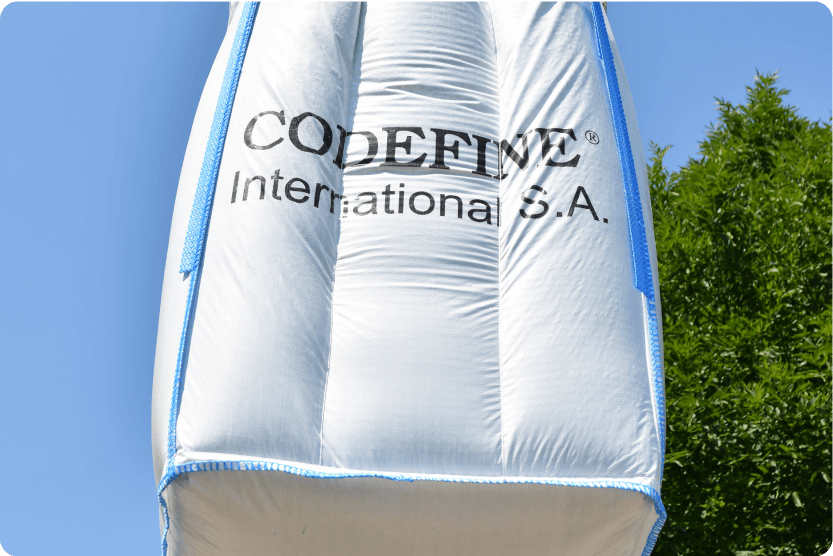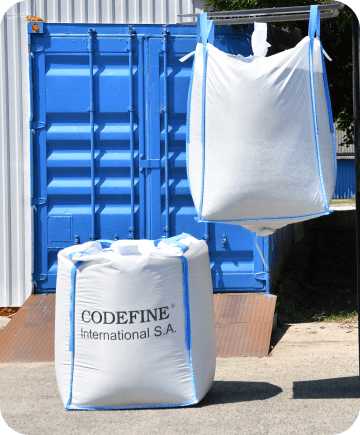Home » Posts Page » Blog » Products and Materials » The Role of FIBCs in Supply Chain Logistics

FIBCs combine impressive load capacity with remarkable versatility, handling anywhere from 500 to 2,000 kilograms while folding to virtually nothing when empty. This woven polypropylene construction creates space efficiency that warehouse managers dream about and financial controllers appreciate even more.
The FIBC family splits into four distinct categories based on static electricity management. Type A bags handle non-flammable materials in safe environments without any special precautions. Type B versions incorporate antistatic fabrics for materials that generate some electrical concern but don’t require complete protection. Type C bags include conductive elements and grounding systems for highly flammable substances where static discharge could trigger disasters. Type D represents the latest innovation, using specialized fabrics that eliminate static risks without grounding requirements, perfect for facilities managing diverse product portfolios.
Shape variations solve specific handling challenges that standard containers can’t address. Circular designs work fine for basic applications, but baffle bags use internal panels to prevent bulging, which makes stacking nightmarish. U-panel constructions provide extra strength for heavy loads, while Q bags feature square bottoms that maximize warehouse storage efficiency where space costs serious money.
The collapsibility factor separates FIBCs from rigid alternatives in a dramatic fashion. A single FIBC can replace dozens of drums while occupying a fraction of storage space when empty. This feature proves particularly valuable for seasonal operations that would otherwise struggle with empty container storage, allowing facilities to maintain flexibility without sacrificing warehouse real estate.
Equipment compatibility makes FIBCs attractive across diverse operations since they work seamlessly with existing forklifts, cranes, and automated systems. This compatibility eliminates expensive infrastructure investments while creating operational flexibility that bridges small-package handling and industrial bulk systems.
Cost savings from FIBCs extend far beyond obvious packaging reductions, reaching into procurement simplification and inventory management streamlining. Operations handling massive daily volumes discover that these benefits accumulate rapidly, sometimes exceeding initial projections by substantial margins.
Transportation economics undergo a complete transformation when FIBCs enter the equation. Their flexible structure maximizes available space in trucks, containers, and rail cars while conforming to irregular spaces that rigid packaging wastes. This efficiency translates directly into fewer shipments for equivalent volumes, reducing freight expenses while simultaneously shrinking environmental footprints.
Warehouse operations experience perhaps the most dramatic efficiency improvements when FIBCs replace traditional packaging systems. Teams transition from managing thousands of individual packages to handling hundreds of predictable bulk containers that stack safely and behave consistently. Storage planning becomes straightforward while space utilization improves dramatically, yet the real transformation occurs when empty containers collapse, providing warehouse managers with unprecedented flexibility.
Labor productivity gains often surprise operations that implement FIBCs systematically. Processes requiring multiple workers can frequently be managed by single operators with appropriate equipment, cutting direct labor costs while reducing physical demands on staff. This efficiency addresses budget pressures and workplace safety concerns through one strategic change.
Speed improvements create cascading effects throughout supply chains when FIBCs become standard operating procedure. Reduced loading times decrease vehicle dwell periods at facilities, while quicker material handling enables more responsive production scheduling. Simplified inventory tracking accelerates order processing across all operations, creating compound time savings that enhance responsiveness to market fluctuations and customer demands.
Peak season resilience becomes apparent when logistics systems face maximum stress. Operations using FIBCs demonstrate superior scaling capabilities compared to those constrained by inflexible packaging systems, maintaining service levels during challenging periods when others struggle with capacity limitations.
Chemical manufacturing presents extreme bulk handling challenges that specialized FIBCs address through innovative design and safety features. Operations managing corrosive powders through volatile compounds require packaging that maintains strict safety protocols while enabling efficient movement through complex distribution networks.
Type C and Type D FIBCs excel in environments where flammable materials create static electricity risks that could trigger catastrophic events. Specialized construction prevents dangerous discharges while chemical-grade liners protect against moisture intrusion and product leakage that could compromise material quality or environmental safety.
Single-use FIBC adoption has grown among chemical companies seeking to eliminate cross-contamination risks between different products. This strategy simplifies cleaning validation while ensuring product purity throughout distribution, addressing quality control and regulatory compliance through one operational change.
Food processing relies heavily on food-grade FIBCs manufactured under stringent hygiene protocols for transporting bulk ingredients including flour, sugar, and grains. These specialized containers incorporate FDA-compliant materials and tamper-evident features that maintain product integrity throughout extended supply chains.
Traceability capabilities built into premium food-grade FIBCs support comprehensive documentation requirements that modern food safety standards demand. Batch-specific tracking enables rapid quality issue response while tamper-evident designs provide visual confirmation of content security during transport and storage phases.
Modified atmosphere FIBCs and moisture barrier versions ensure ingredient quality for products requiring special handling conditions. These designs help manufacturers maintain consistent quality regardless of environmental variations, addressing persistent challenges in food ingredient logistics.
Pharmaceutical manufacturing operates under extraordinarily strict regulations that pharmaceutical-grade FIBCs help navigate while maintaining operational efficiency. These containers feature certified materials manufactured in controlled environments with documentation packages that satisfy regulatory requirements.
Closed-system designs minimize contamination risks during transport and handling while protecting product integrity and worker safety. Their ability to maintain sterile conditions makes them ideal for moving active ingredients and excipients between facilities while meeting Good Manufacturing Practice standards.
Insulated FIBC variants provide thermal protection for temperature-sensitive compounds during transport and storage. This specialized construction helps maintain cold chain integrity without requiring complete refrigerated transport, reducing costs while ensuring product quality.
Construction operations embrace FIBCs for their exceptional durability when handling abrasive materials including cement, sand, and aggregates. Specialized abrasion-resistant constructions withstand harsh conditions that destroy standard packaging while delivering extended service life in demanding environments.
Precise delivery capabilities make FIBCs ideal for projects requiring specific quantities at exact locations. Crane compatibility enables positioning accuracy impossible with loose material delivery while reducing waste and improving project efficiency.
Agricultural operations depend on FIBCs throughout growing cycles, from seed distribution through fertilizer application to crop collection. UV-stabilized varieties endure outdoor conditions during planting and harvesting, while ventilated designs enable moisture regulation for stored crops.
Scalability makes FIBCs valuable across operation sizes, from large commercial farms to smaller regional operations. Compatibility with existing equipment eliminates specialized machinery requirements, making them accessible without major infrastructure investments.
Feed and fertilizer distribution benefits from the clean discharge characteristics that bottom-mounted spouts provide. Controlled material flow minimizes waste and environmental impact while simplifying application processes for busy agricultural operations.
Mining operations test FIBCs under extreme conditions, transporting the heaviest and most abrasive materials in industrial settings. Extra-reinforced designs with specialized lifting systems handle weights that would destroy standard packaging, while abrasion-resistant fabrics endure constant contact with sharp materials.
Remote operations with limited infrastructure find FIBC versatility particularly valuable. Empty containers can be transported to isolated locations and filled using basic equipment, making them ideal for operations distant from established logistics networks.
Dust containment properties address environmental and health concerns by preventing particulate release during transport and storage. This capability helps mining companies meet environmental regulations while protecting worker health.
Successful FIBC implementation requires attention to storage conditions that maintain container performance while ensuring operational safety. Stacking limitations typically restrict heights to three bags unless specialized stable-design varieties are used, while outdoor storage requires UV protection through covered areas or resistant materials that prevent degradation from sunlight exposure.
Moisture management becomes critical for hygroscopic materials that absorb atmospheric water. Proper humidity control in storage areas, dehumidification equipment when necessary, and moisture-barrier FIBCs for sensitive products can prevent costly losses from improper storage conditions. Temperature control similarly protects sensitive contents, particularly in food and pharmaceutical applications.
Quality assurance must span the complete FIBC lifecycle, beginning with thorough inspection of empty containers for manufacturing defects. Seam integrity, lifting loop attachment, and fabric condition require careful examination before acceptance, while filled container inspection ensures proper loading and closure security. Periodic load testing confirms ongoing performance throughout supply chains.
Safety protocols intensify when handling FIBCs containing hazardous or valuable materials. Personnel training on proper lifting techniques with appropriate equipment becomes essential, with strict prohibition of workers beneath suspended loads. Conductive Type C bags require established grounding procedures before filling or emptying to prevent static discharge risks.
Maximizing FIBC value requires more than standard catalog ordering. Codefine International SA approaches client challenges through comprehensive supply chain analysis, identifying optimization opportunities that initial assessments might miss.
Their engineering team develops custom FIBC bulk bags addressing specific operational challenges, whether handling corrosive chemicals, fragile pharmaceutical ingredients, or abrasive construction materials. Technology integration distinguishes Codefine solutions in increasingly connected industries. Their tracking systems integrate seamlessly with warehouse management and enterprise resource planning platforms, providing real-time visibility into material locations throughout complex supply chains. This integration extends to automated systems, conveyor interfaces, and discharge stations, creating comprehensive material handling ecosystems serving agriculture, chemicals, construction, food, pharmaceuticals, mining, and recycling industries.
Looking for quality bulk bags you can trust? At Codefine, you’ll find premium bulk bags at affordable prices. Are you searching for other packaging solutions? Explore our entire product range online today or get in touch with the team to discuss your requirements in more detail.
